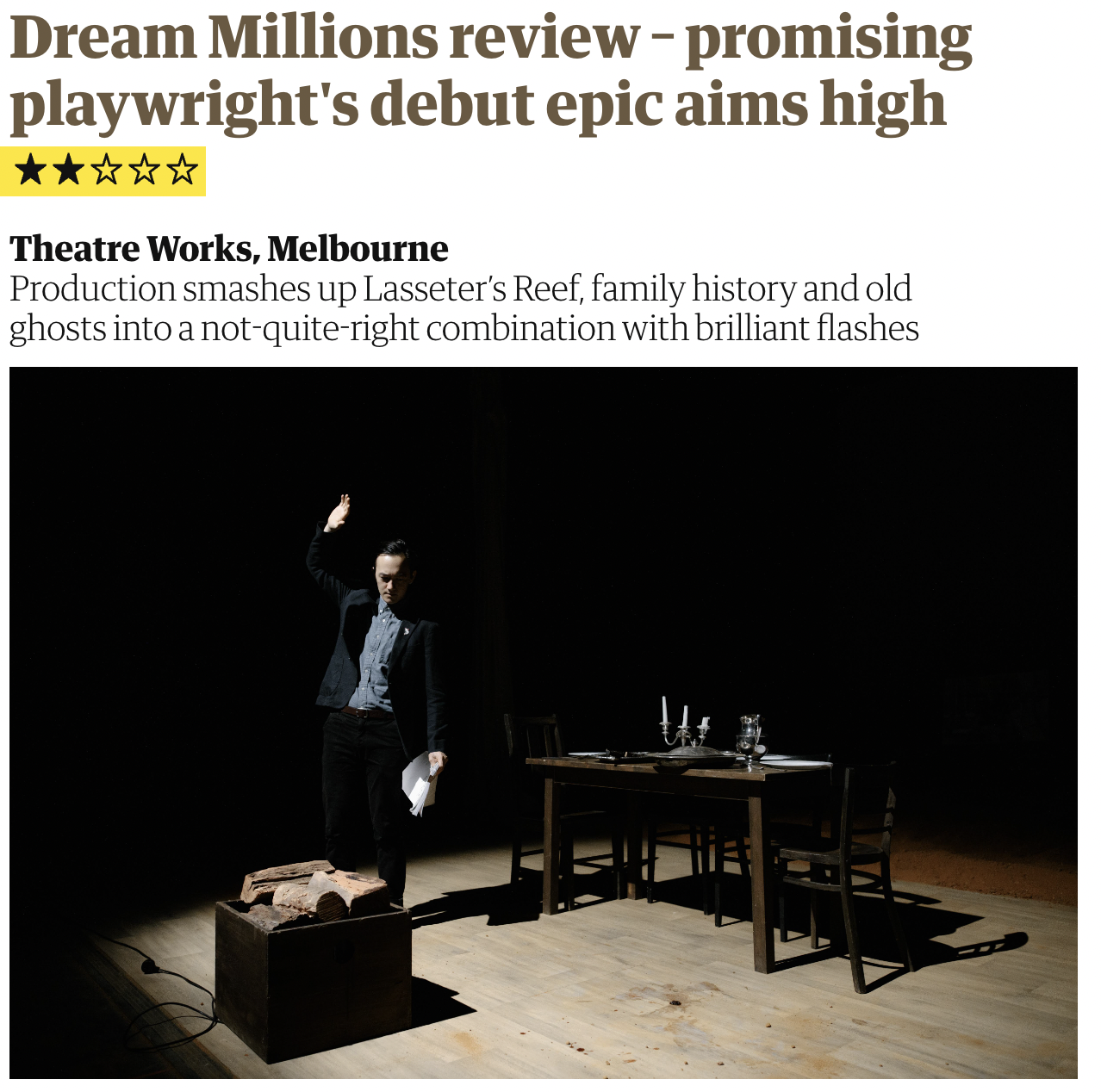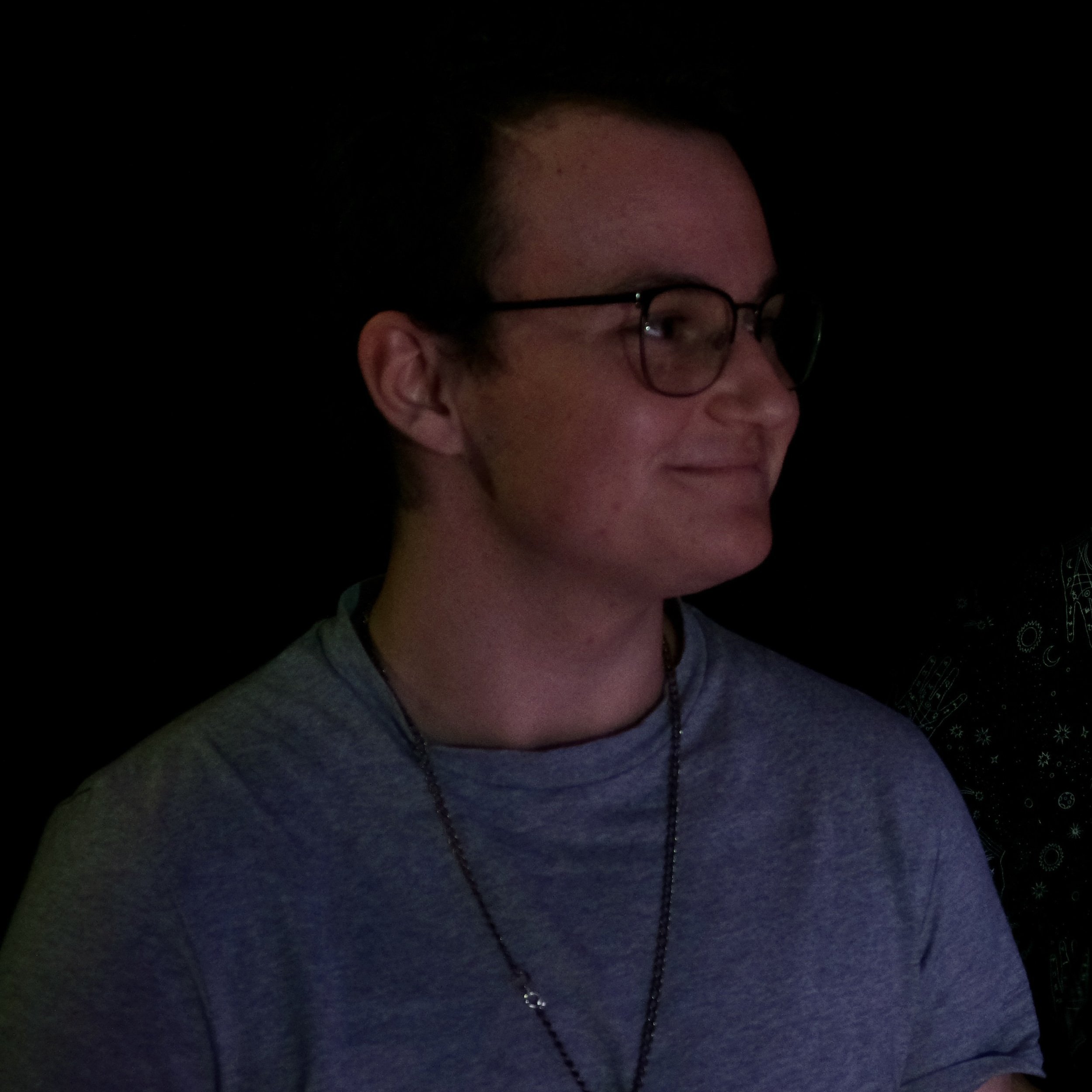

CREDITS
Writer - Kim Ho
Story by - Kim Ho and Saro Lusty-Cavallari
Director/Video and Sound Designer - Saro Lusty-Cavallari
Producer - Imogen Gardam
Set and Costume Designer - Kate Beere
Lighting Designer - Kate Baldwin
Stage Manager - Justice Georgopoulos
Associate Producer - Rachael Adamson
Set Builder - Tom Fayer
Production Photography - Phil Erbacher
Promotional Photography - Bryn Chapman Parish
STARRING
Geb - Lucinda Howes
Dem - Kurt Pimblett
Ash - Rachel Seeto
Eli - Idam Sondhi
Cal - Mây Trần
Audio and Video Performances
Imogen Gardam
Kim Ho
Saro Lusty-Cavallari
Shari Sebens
An earlier - and substantially different version - of The Great Australian Play first premiered in Melbourne at Theatre Works on February 19th 2020. We thank the original cast and crew for their invaluable contribution in developing this work.
Director/Sound Designer - Saro Lusty-Cavallari
Producer - Imogen Gardam
Dramaturg - Carissa Lee
Cultural Consultant - Sermsah Bin Saad
Set Designer - Claudia Mirabello
Costume Designer - Carmody Nicol
Lighting Designer - Nicholas Moloney
Stage Manager - Max Woods
Assistant Stage Manager - Brooke Simmonds
Stage Hand - Natalya Shield
Cast
Tamara Lee Bailey - Ash/Blakeley/Daughter/Wombat Lady
Sermsah Bin Saad - Dem/Lasseter/Father/Pokie Machine/”Miranda”/Johann Ulrich Voss
Daniel Fischer - Eli/Coote/Son/Hiatus Brown
Sarah Fitzgerald - Cal/Unidentified Lasseter Explorer But NOT Mickey The Tracker/Mother
Jessa Koncic - Geb/Sutherland/The Fidgeter/Santa Clause

A Note From The Director
Four years. Three prime ministers. One pandemic. A handful of lockdowns. Two seasons.
Myself and Kim have been living with The Great Australian Play for the last four years, continually digging into the strange mythos that the play has developed over stagings, redraftings, retitling and redevelopments. From a first read at the Victorian College of the Arts to a season at Theatre Works that was to be one of the last productions pre-pandemic to the version you now see, we have been constantly pouring over the insane world of “GAP” as we affectionately call it for all of those four years. We’ve interrogated the logic of this world and slowly drawn out an order from the brilliant chaos that so excited me when I read Kim’s earliest draft in September 2018.
I was recently revisiting the initial email Kim sent to me then, asking if we could collaborate on this play. What I had forgotten was that the original title was ‘Apocrypha’. My understanding was that the enormity of history, of mythologies, of factoids, of the stories we tell ourselves about our country were a murky web of contradictions and half-formed identity that Kim was trying to pick apart. While we ended up with a far more provocative and marketable title I still think of the idea of ‘Apocrypha’ as a way to understand this play. This is a story about stories; how we tell them and what they do for us.
I don’t think there’s much more either of us can say about this work anymore. We could ‘explain it’ and ruin the mystery at its heart or we could smother it in sociopolitical babble that would make us feel clever and enrich your enjoyment very little. Instead we have provided a series of “Appendices”, little pieces of in-universe apocrypha that looks at the world of this play from varying angles. Read them before you sit down to watch the play or enjoy them on the way home to help shed light on this strange and fragmented story.
-Saro Lusty-Cavallari, September 2022

APPENDICES
Appendix A
”PHANTOM GOLD”
Author Unknown. Singleton Argus Mon 21 June 1937.
Retrieved September 12, 2022 from Trove, National Library of Australia.
The epic story of Lasseter's lost reef has attracted such a wealth of attention during the last few years that Mr H. V. Foy, curious as to what the country really looked like, decided to equip and lead an expedition into that little known land. "Lasseter's Land," as it is known to those of the interior. On his return, and after viewing the splendid motion picture record of the adventurous journey, it was decided that the story of the true facts of Lasseter and his reef would be of tremendous interest if told as a real Australian feature film. "Phantom Gold" is the tale of 'Lasseter's reef, and its attendant expeditions, forced landings, and the tragic ending which closed probably forever the door to the reef, which Harold Lassctor claimed to have found about 30 years previously. And now all this is brought to the screen, in. all its tragic dramatic truth by Rupert Kathncr, who's masterly directing of such an epic adventure places him in the forefront of Australian directors. Associated with him in the production is Mr Stan Tolhurst, who plays the tragic role of Lasseter. Mr Tolhurst - who referred to himself as “Dem the Drover” to the confusion of others - has no previous performance credits and in fact approached the picture’s financers when he discovered their intentions. Others in the cast are people actually re-living their own past adventures—Bob Buck, Australia's greatest living bush man, the nma who, in fact, found Lassoter's body; Capt. W. L. Pittendrigh, pilot of the "Golden Quest" 'plane which was forced down in the search; Bryce Russell, Lasseter's partner; Reg. King, experienced bushman and mining engineer and "Old Warts," Lasseter’s native companion. This group of men all commented on the uncanny way in which Mr Tolhourst brought their former compatriot to life in front of the screen. These striking echoes of a real-life adventure bring to the Plaza screen a story that every Australian will want to see and enjoy, being, as it is, an Australian film that even the severest critics could not find fault, some even claiming for it the title of Australia's greatest screen drama. The associate feature is the adventurous sea drama, "Ship of Wanted Men."
Appendix B
Dream Millions review – promising playwright's debut epic aims high
Van Badham. The Guardian Australia, Mon 24 February 2020.
Retrieved September 08, 2022.
Kim Ho is a young Australian playwright who has notched up some impressive career successes. A touching short film he wrote as a teenager went viral, drawing praise from Stephen Fry and Ellen DeGeneres. He’s also won enviable awards, and with them the notice of the main-stage theatre companies.
The premise of his new indy showing at Melbourne’s Theatre Works certainly intrigues. Dream Millions promises to explore the Australian legend of Lasseter’s Reef through his own tenuous connection with head of the expedition Fred Blakeley. Ho charts Blakeley’s path from washed up bushman to gold digger to anachronistic native title sympathiser. It’s not necessarily a bad idea on paper but Ho ends up tying himself into knots making sure no stone is left unturned in his own retelling.
At the height of the great depression in 1930, Lasseter managed to raise both £50,000 and fervent hope in an expedition to find the gold and rescue Australia from its poverty. They ran into difficulties, the gold was not found, and the prospecting party denounced Lasseter as a charlatan and abandoned him. His lonely body was found in the desert a year later.
But in order to get his expedition funding he had to partner up with ‘bicycle bushman’ Fred Blakeley. Blakeley immediately begins to resent Lasseter’s flamboyant tall tales and loses faith in the reef’s existence. By the time the two part ways, the reef is no closer in sight and Blakeley declares the presumed dead Lasseter a fraud. In Blakelye’s own memoir (written on the typewriter of Ho’s own grandfather) he contrasts his growing disillusionment with Lasseter’s quest with his increasing empathy towards ‘the sandhill people’; Aboriginal Australians encountered during the expedition.
It’s a strong story for Ho to explore; the turning away from a grand act of colonial plunder towards a conciliatory vision of Australia’s future. Unfortunately Ho can’t help but second guess himself at every turn. He both romanticises Blakeley’s increasing sympathy towards the plight of First Nation Australians while cringing at such conciliatory politics. Ho is clearly touched by his familial connection to the expedition (one so tenuous most audience members would be hard pressed to follow it) but is uncomfortable with the unabashedly colonial overtones of the myth he’s placed himself in.
There’s certainly a degree of hutzpah in promising both a rollicking patriotic adventure and an unflinching exploration of Australia’s early folly. But with that much on your plate you better not drop it. Alas, Ho does. Dream Millions prods at an Australian cultural canon in which the heaviest trope is of non-Indigenous locals terrorised by landscape. But Ho’s fresh takes on a theme that saturates local literature get hopelessly lost – not within impenetrable wilderness but amid incoherent structural choices and overwriting, and clumsy stagecraft. How lost? The play is billed at lasting 120 minutes. We were there for 210.
The direction is so uncertain as to whether we are witnessing a memory, a reconstruction or a play within a play, that the next two hours are spent in confusion – utterly unhelped by lighting design that can’t decide if the audience should be allowed to see things or not. Soon enough scenes crash into one another without schema, pauses are made for prolonged movement sequences, Ho walks onstage to confront Blakeley for his shortcomings, and then Paul Keating turns up.
As a director, Caspar Renwick makes an excellent choreographer. By some margin, the movement work is the most effective contribution to the production. Unfortunately these sequences are so bereft of dramaturgical connection to the rest of the story. Renwick shows a clear knack for the body’s movement when free from Ho’s stifling prose. However this skill disappears entirely once he remembers he’s making theatre and not dance, replaced by awkward stage placement of actors and props, and interminable exits and entrances.
Actor Jeremi Campese shows an energetic potential for comedy that’s consistently misdirected into stage mania. Annie Stafford seizes at two isolated monologues in the script that allow her to actually do some acting and delivers moments so beautiful that while they can’t save this play they do rescue Ho’s reputation as a writer of potential. These moments prove he can turn a line – and while his emerging theatrical ideas aren’t coherent in Dream Millions, it’s cause for some excitement that he’s having them.
For that reason, if you have a spare 210 minutes and the curiosity, Dream Millions is worth a visit. Not because it lives up to the titular dream but because it illustrates in one or two strong moments amid its failed experiments what a long and difficult expedition that dream re
The Chunderful Gizzard of Oz: The Whole Story Behind THAT Logies Moment
Abbie Blakeley. PEDSESTRIAN.TV. Wednesday, June 13 2020
Retrieved September 13th 2022
An Aussie screenwriter just shat and vommed on stage at the Logies, proving truth is stranger – and far more explosive – than fiction.
It’s Australian TV’s night of nights, but the Logies are also notoriously the loosest of our entertainment award ceremonies.
Every year they’re plagued by scandals: that time Steve Irwin’s snake literally bit Tim Webster; when Karl Stefanovic turned up to the Today set the next morning still drunk; or when walking sacks of mashed potato reliably beat out their far more talented colleagues of colour.
But no scandal was more, uh, mellifluous than that concerning Gina Erin Bozovski and her apparently infinite deposits of projectile vomit and explosive diarrhea.
You heard that right. An Aussie screenwriter just shat herself on stage whilst accepting her award… and then chundered all over herself. And Grant Denyer.
Strap in. Here’s the full sordid story.
Shartistic Excellence
At only 28, Gina Erin Bozovsky was by all accounts a rising star of Australian screen. She’s been mentored by industry giants, won the John Hinde Award for science fiction writing and was the youngest recipient of an AACTA Award for Best Adapted Screenplay for her work on ABC’s The Fatal Shore.
In 2020, she raised eyebrows by turning down an offer from Screen Australia to undertake a residency in Los Angeles, saying, “Those American ***** couldn’t handle my ****** ** ********** *** ******* ***********.
Indeed, some speculate that it was Bozovski’s flair for language that inspired the Logies committee to create an entirely new award, the Gold Logie for Best Story, in 2021.
Bozovski was nominated for her work on Love Changes Everything: The Alan Jones Story, alongside Alice McGooley for Diary of an Asylum Seeker, Mac Peters for Dumpster Doctor Season 3, Jacqueline Groscht for her new Tasmanian noir series, Murder on the Derwent, and Damian Pounder for Ned Kelly: The Untold Story.
Against all odds, the reclusive writer from Zetland beat out the old hands to become the inaugural winner of this brand new category – an unprecedented upset in the Aussie TV landscape.
That’s where everything went wrong.
Yakult, Ya Fukt
Industry insiders describe Bozovski’s professional behaviour varying from unconventional to erratic to downright unsettling, with some colleagues (who wish to remain unnamed) describing her watching porn on her phone during writers’ rooms and only ever consuming jumbo packs of Cheetos and cans of V.
More recently, rumours spread about Bozovski’s alleged cocaine use. In the words of one writer who worked with her: “Gina would excuse herself to go to the bathroom a few times an hour, but would also let us all know she had chronic constipation. We knew nothing was coming out. It was obvious she was going in there to snort a line.”
“She started getting nosebleeds and blamed it on the aircon,” another of Bozovski’s colleagues told me. “The building didn’t have aircon.”
What did she do to address her chronic constipation? Did she go to a doctor? Get a prescription?
“It would get to the point where Geb would down half a dozen Yakult in a day to try and, y’know, get some bowel movement,” this colleague said.
“The next day she wouldn’t show up to work. It was like clockwork. Cheetos and V, coke, Yakult, day off. She’d have been unhireable a long time ago but she’s just such a goddamn genius, so we put up with it.”
#Shomitgate
Which brings us to Logies Night.
To be clear, there is no implication by this publication that Gina Erin Bozovski became constipated by heavy cocaine use, then used Yakult to get her bowels moving before the Logies, but mistimed the flush-out and ended up erupting out of both ends at the worst possible moment.
But it would explain why her vomit was purple.
Bozovski arrived in what appeared to be a pleather power suit. Eyewitnesses said she was shifting uncomfortably in her seat, with one overhearing her allegedly say: “Calum Scott had better hurry the f*** up because I’m about to unleash a tsunami in the toilets like the one in The Impossible. Where’s Naomi? She’d better watch out.”
The rest is history. No sooner had Gina Erin Bozovski named the inaugural recipient of the Gold Logie for Best Story, she made herself the first person ever to shit themselves on the Logies stage (that we know of).
It was a truly eldritch spectacle seared into the retinas of all unlucky enough to bear witness.
Watch the whole sorry affair here, if you dare:
[Video not supported.]









CAST & CREW
RACHAEL ADAMSON - ASSOCIATE PRODUCER
Rachael Adamson is a young Sydney producer and UNSW student with credits both within NUTS and the independent Sydney theatre scene. Her recent credits include associate producing Tom at the Farm at KXT (2022), and The Pass at the Seymour Centre (2021) both with Fixed Foot Productions, producing Arsenic & Old Lace for NUTS (2022), producing Dancing with Drip Poles with Eye Contact Theatre and Temporary with Lateral Productions for Flight Path Theatre (2021, cancelled), producing Rossum’s Universal Robots for NUTS (2021), assistant producing & stage managing Gritty In Pink for Sydney Fringe Festival (2019) and developing, producing and co-directing the original concept online show Is This On? (2020). Rachael’s design credits include graphic design for Sydney Fringe Festival's Is This Thing On? (2021, cancelled), the Sonic Sydney audio project (2020) and various freelance graphic design. Her costume design credits include Tom at the Farm, Legally Blonde the musical (2021, cancelled) and Embers (2021, cancelled). Rachael is also currently producing You Stupid Darkness! (NUTS, 2022).
KATE BALDWIN - LIGHTING DESIGNER
Kate Baldwin is an emerging Japanese-Australian Lighting Designer, who lives and works on the lands of the Gadigal and Wangal people of the Eora Nation. She is a Design Associate at Sydney Theatre Company.
Since graduating from NIDA in 2019, some of her credits as Lighting Designer include; Nothing (National Theatre of Parramatta), Tom at the Farm (KXT), Albion (New Ghosts Theatre Company, Secret House & Seymour Centre), Top Coat (Sydney Theatre Company), The Box Show (Critical Stages Touring & Junkyard Beats), Guards at the Taj (National Theatre of Parramatta), Chewing Gum Dreams (Green Door Theatre Company and Red Line Productions), seven methods of killing kylie jenner (Darlinghurst Theatre Company and Green Door Theatre Company), Ching Chong Chinaman (Slanted Theatre), and House at Boundary Road, Liverpool (Bontom). She was also Design Associate (Lighting) for Death of a Salesman (Sydney Theatre Company).
She is also a part of developing Salt Baby (Ka-llective), which had a residency with PACT in 2021.
KATE BEERE - SET & COSTUME DESIGNER
Kate Beere is a costume and set designer working across theatre, film and events. She has a love for creating and collaborating with passionate artists and directors. She enjoys designing spaces that can set the tone and also intertwine cohesively with the work. Kate completed her Masters of Fine Arts (Design for Performance) at NIDA in 2020 and prior to this, completed the BFA (Design for Performance).
Kate’s recent design credits include Half Time (Hayes Theatre), This Genuine Moment (Old 505, La Mama), Alibi (or Someplace Else) (Old Fitz Theatre), Significant Other (New Theatre), and Tom at the Farm (KXT).
IMOGEN GARDAM - PRODUCER
Imogen Gardam is co-founder and co-director of Montague Basement, producing the group's 18 productions since formation in 2014. She is the Senior Producer at Griffin Theatre Company and has worked in theatre and film for Bell Shakespeare, Hopscotch Features, Entertainment One Australia and The Festivalists. Imogen is a graduate of Media and Communications from the University of Sydney and is currently completing a Masters of Research in Film Studies. She is also one half of independent company FERVOUR., most commonly found on producing duties. Imogen was the 2018 winner of the Rose Byrne Scholarship for an Emerging Female Leader in the Arts, and served on the Board and as Deputy Chair for Theatre Network NSW from 2018-2020. Imogen has been published in Lumina Journal, Audrey Journal, Honi Soit and on Four Three Film.
JUSTICE GEORGOPOULOS - STAGE MANAGER
Justice holds a Diploma of Theatre Media from Charles Sturt University and is currently studying a Bachelor of Theatre Making at the University of Wollongong. He has stage managed several amateur and University productions, but The Great Australian Play marks his industry debu
KIM HO - WRITER
Kim Ho is a playwright and screenwriter based in Naarm (Melbourne). Their work frequently explores genre subversion, magical realism and moments of uncanny encounter. Kim is a writer on the ABC drama series THE NEWSREADER, which was nominated for an AACTA Award in 2021 for Best Television Screenplay. Kim’s short film THE LANGUAGE OF LOVE screened at over thirty film festivals worldwide, including the 2014 Sundance Film Festival. They also have a number of television projects in development, including their crime-comedy series MELBOURNE VICE.
Kim won the 2018 Patrick White Award for their play MIRROR’S EDGE. Their satire THE GREAT AUSTRALIAN PLAY premiered at Theatre Works in 2020 and received Green Room Award nominations for Best Writing and Best Production. Their drama BURIED KINGDOM, co-created with Michelle Ny, received a staged reading at the 2019 Typhoon Festival in London. Kim is currently under commission for Malthouse Theatre to develop a folk horror play, HAVENHOLM.
LUCINDA HOWES - GEB
Lucinda Howes completed WAAPA’s three-year acting program in 2019. Despite graduating into a COVID filled 2020, she has been lucky enough to perform in multiple productions in the past two years. In 2021, she appeared in ‘Twelfth Night’ (New Theatre) ‘Videotape’ (KXT, Montague Basement) and ‘Fuente Ovejuna!’(Dream Plane Productions). In 2022, Lucinda was part of the principal cast for both 'Attempts on Her Life' (KXT, Montague Basement) and 'Hotel' (NIDA's Festival of Emerging Artists). She performed in Sport For Jove’s HSC Symposium Series in March and will play Nina in Bagryana Popov’s production of ‘The Seagull’ in conjunction with La Mama Theatre later this year.
SARO LUSTY-CAVALLARI - DIRECTOR/VIDEO AND SOUND DESIGNER
Saro is a Sydney-based theatre director, playwright and video designer. He is the co-founder and co-director of Montague Basement and a graduate of VCA’s Masters of Directing for Performance. His directing credits include, Videotape (KXT) and Animal Farm (New Theatre) which he also wrote, as well as Sarah Kane’s Cleansed (PACT), Rainer Werner Fassbinder’s Blood On The Cat’s Neck (KXT PopUpstairs) and Martin Crimp’s Attempts On Her Life (KXT). He has interned with some of Australia’s leading directors including Peter Evans, Leticia Cáceres and Eamon Flack.
KURT PIMBLETT - DEM
Kurt Pimblett is a queer artist and member of the 2020 graduating company of the Victorian College of the Arts (BFA Acting). Kurt’s stage work includes originating and touring the role of Tom in Hearth (La Mama, 2022), playing Laertes in Because The Night at Malthouse Theatre (2021), Max in Belvoir's award winning production of Hir (2017), and multiple roles in Melbourne Theatre Company’s Cybec Electric readings (2020). He has also appeared in numerous independent theatre productions, including Love You Bitch (Stage Mom, Midsumma 2020), and Cleansed (Montague Basement, Sydney Fringe Festival 2017). Kurt’s screen work includes short film Drainrats (2021), TikTok webseries Scattered (2021), and feature film In The Meantime (due for release in 2023).
SERENA POLLOCK - DESIGN ASSISTANT
Serena Pollock is a Sydney based designer and collaborator with a background in movement-based theatrical works. Undergoing studies in Design at the National Institute of Dramatic Art (NIDA), she has assisted on such productions as Eat Me (NIDA), God's Country (NIDA), and most recently Channel 10’s "The Masked Singer". Serena has a passion for supporting independent theatre within Sydney, especially new works with a diverse range of theatrical story-telling.
RACHEL SEETO - ASH
Rachel is a multidisciplinary artist, actor, and graduate from the National Art School. Her practice unravels memory, time, our relationship to place, and seeks to explore what lies between plain sight. When she’s not creating with her hands, she’s creating for the stage with recent credits including Moon Rabbit Rising (Little Eggs Collective), Too Human (NIDA Festival), CODE, We Regret To Inform You That (Short+Sweet) and Dumb Kids (KXT). She has also been involved in developments and readings such as The Lab Report (Montague Basement/KXT), Intersection: Unleashed, Fresh Ink (ATYP) and Girl Running, Boy Falling (KXT Storytellers).
IDAM SONDHI - ELI
Idam Sondhi is an actor and a film/stage enthusiast. He has been in the world of creative arts since the age of eight. Idam grew up in Auckland, New Zealand and has been residing in Sydney for the last three and a half years.
Some of his recent theatre credits include U.B.U (Kings Cross Theatre/Tooth and Sinew), Yellow Face (Kings Cross Theatre/Dinosaurus Productions), Much Ado (Flight Path Theatre/Not Model Attractive) and Guards At The Taj (Riverside Theatres/NTofP). Idam can also be seen most recently in mini series Underbelly: Vanishing Act for Nine Network.
Idam studied acting and screenwriting at NYFA and Ivana Chubbuck Studios in Los Angeles and Improv Theatre Sydney.
MÂY TRÂN
Mây Trần is Western Sydney based performer, problematic Gen Z homo, and retired Woolworths employee of Vietnamese descent. Their most recent credits include Cleansed (dir. Dino Dimitriadis) at the Old Fitz Theatre, Hot Mess (dir. Tasha O’Brien) at KXT, and PLAYLIST (dir. Karen Therese) at the Sydney Opera House.
They are currently working on their first solo work, Palatable, in partnership with PYT Fairfield.
SPECIAL THANKS
The Genesian Theatre
Griffin Theatre Company
Alexander Berlage
Annika Bertinat
Sean Brehon
Dino Dimitriadis
Aaron Murray


















